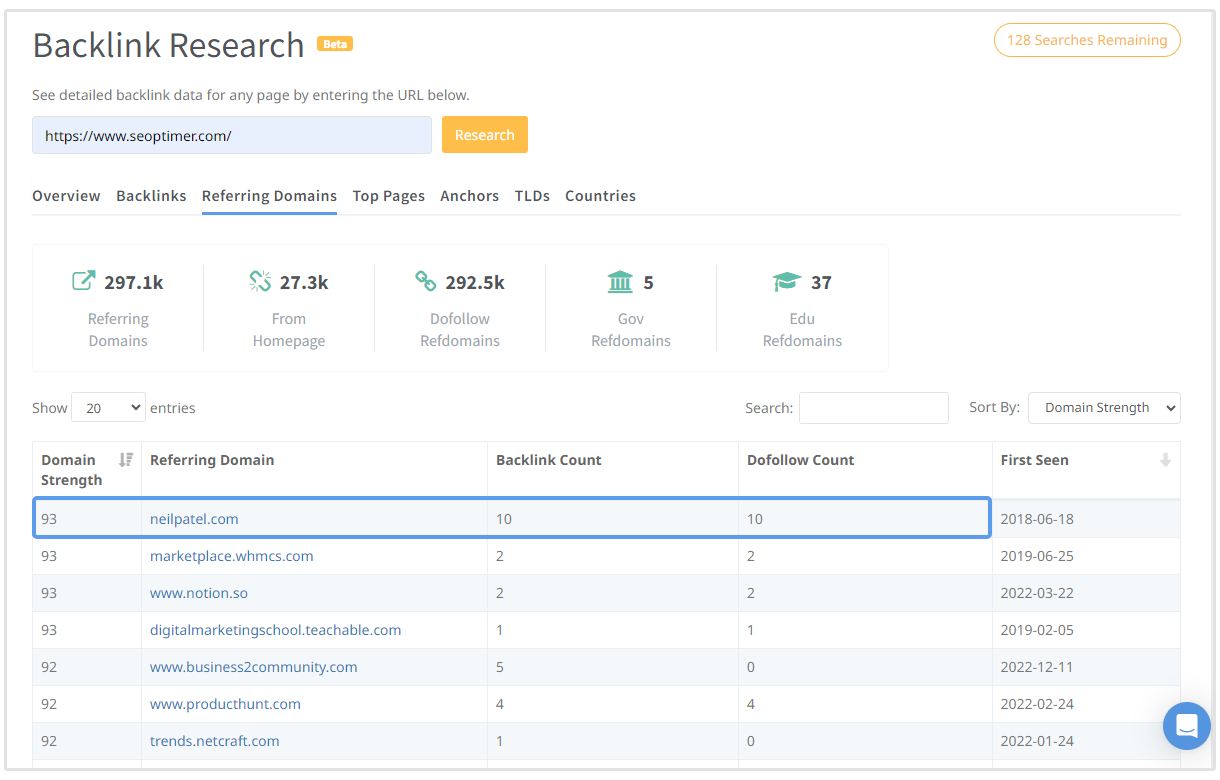
When it comes to search engine optimization (SEO), there are countless factors that influence a website's visibility and ranking.
Among the factors that play a role are backlinks and referring domains. However, understanding the difference between backlinks vs referring domains and which is most important can be a bit confusing to new marketers.
In this article, we will explain what the differences are between backlinks and referring domains. Additionally, we will provide you with actionable steps on how to check any website's backlinks and referring domains..
What is a Backlink?
A backlink is a hyperlink that directs users from one webpage to another. When a website includes a link that leads to your website, it is considered a backlink.
Think of it as an online recommendation or "votes" as some people call it. The more reputable websites that link to your site, the more authority and credibility it gains in the eyes of search engines.
Think of it like this: you write an insightful article about the best medium-sized dog breeds.

Another website, impressed by your content, includes a link to your article in their own blog post on pet care. This link becomes a backlink for your article, boosting its online visibility and potential reach.
The more high-quality backlinks you acquire, the more "popular" your website becomes in the eyes of search engines like Google, ultimately improving your ranking in search results.
What is a Referring Domain?
A referring domain refers to any unique website that contains one or more backlinks pointing to your website. In simpler terms, it is a website that acts as a source or origin of backlinks pointing to your site.
Unlike backlinks, which focus on individual links, referring domains consider the overall number of unique websites linking to your site.
Think back to our dog breed article example. If another website, like a popular pet magazine, links to your article, the pet magazine itself becomes a referring domain. Even if they only link to your article once, they're still considered a referring domain because they're the source of that backlink.

Search engines analyze the quality and quantity of referring domains to gauge the relevance and popularity of your website, ultimately influencing its organic search rankings.
Difference Between Backlinks vs Referring Domains
Backlinks are individual links, whereas referring domains are the unique websites that host those links. Understanding this distinction is crucial for optimizing your website's visibility and organic search rankings.
Backlinks vs Referring Domains: Which is Most Important?
When it comes to SEO, both backlinks and referring domains hold immense power. However, focusing solely on accumulating a massive number of backlinks can be a shortsighted strategy.
While backlinks represent individual votes of confidence, it's the diversity of referring domains that truly carries the weight in the eyes of search engines.
Imagine two scenarios:
- Scenario 1: Your website receives 100 backlinks, but they all originate from just two referring domains. While this might seem impressive at first glance, it presents a limited picture. Search engines might view this as a manipulative tactic, questioning the genuineness of these backlinks.
- Scenario 2: Your website receives 20 backlinks, but they come from 20 different referring domains. This scenario, despite having fewer backlinks, demonstrates a far stronger and more natural link profile. Search engines see this as a testament to the genuine value and authority of your content, ultimately pushing your website up the search engine rankings.
In other words, having one link from several referring domains is more powerful for your SEO than having multiple links from just a handful of referring domains.

Focusing on quality [backlinks] over quantity is what can help to protect your site as Google updates.
- Adam Riemer, SearchEngineJournal
How a Diverse Link Profile Impact SEO
- Naturalness: A diverse backlink profile mirrors the organic nature of the web, where links are earned through genuine interaction and value exchange. This strengthens your website's credibility and signals trust to search engines.
- Authority: Each unique referring domain adds a vote of confidence from a separate source, amplifying the overall impact and authority of your website.
- Reach: With backlinks from diverse domains, you tap into a wider audience and potential customer base, boosting your website's visibility and reach.
What Makes a Good Backlink?
A good backlink possesses several key elements that contribute to its effectiveness in boosting search engine optimization (SEO) and website credibility.
Here are the essential factors that make a backlink valuable:
- Relevance: A good backlink is relevant to your website's content and industry. It should come from a website or page that shares a similar topic or theme to yours. This relevancy signals to search engines that your website is a reliable source within its niche.
- Authority: Backlinks from authoritative websites carry more weight and credibility. Websites with high domain authority, established reputation, and strong online presence provide valuable endorsements that can positively impact your website's ranking.
- Natural Acquisition: Search engines prefer backlinks that are obtained naturally, rather than through manipulative or spammy practices. A good backlink is acquired through organic means, such as earning it through high-quality content, collaborations, or genuine relationships with other websites.
- Anchor Text: The anchor text, or the clickable text that contains the hyperlink, should be relevant and descriptive. It helps both search engines and readers understand the context of the linked page.

- Diversity: Having a diverse backlink profile, with links from various sources and types of websites, is beneficial. A mix of different referring domains and link types, such as contextual links, guest posts, or editorial mentions, adds depth and authenticity to your backlink profile.
- Quality: The quality of the linking page matters. A good backlink comes from a well-designed webpage with valuable and engaging content. Avoid backlinks from low-quality or spammy websites, as they can harm your SEO efforts.
How to Check Any Site’s Backlinks vs Referring Domains
You can check any website’s backlinks and referring domains using SEOptimer’s Backlink Research tool.
Simply login to your SEOptimer account and click on the “Backlink Research” tab on the left of the dashboard.

Then, add the URL of the website you’d like to check and click on the orange “Research” button. Now you’ll be able to view all the most important backlink metrics for the domain you entered.
The “Overview” tab will show you how many backlinks vs referring domains your website has. This provides a quick and easy way to check a site’s backlink profile and how many links it has in relation to the number of referring domains.

You can also navigate to the “Backlinks” tab to view more detailed information about the individual links pointing to your website. Here you can see metrics such as:
- Domain Strength
- Page Strength
- Referring Page
- Target Page
- Anchor Text
- Follow/Nofollow
If you really want to drill down into how many backlinks vs referring domains your link profile has, then navigate to the “Referring Domains” section.

Here you can see each referring domain, as well as the Backlink Count from each. For instance, in the below screenshot, you can see that the SEOptimer homepage (https://growth.toolzbuy.com/udemy_cloud) has got 10 backlinks from the Neil Patel blog, with all of them being dofollow links.
Conclusion
The comparison between backlinks vs referring domains highlights the importance of diversifying your SEO strategy.
While backlinks are valuable for establishing credibility and authority, it is more powerful to obtain one link from several referring domains than multiple links from just a handful.










